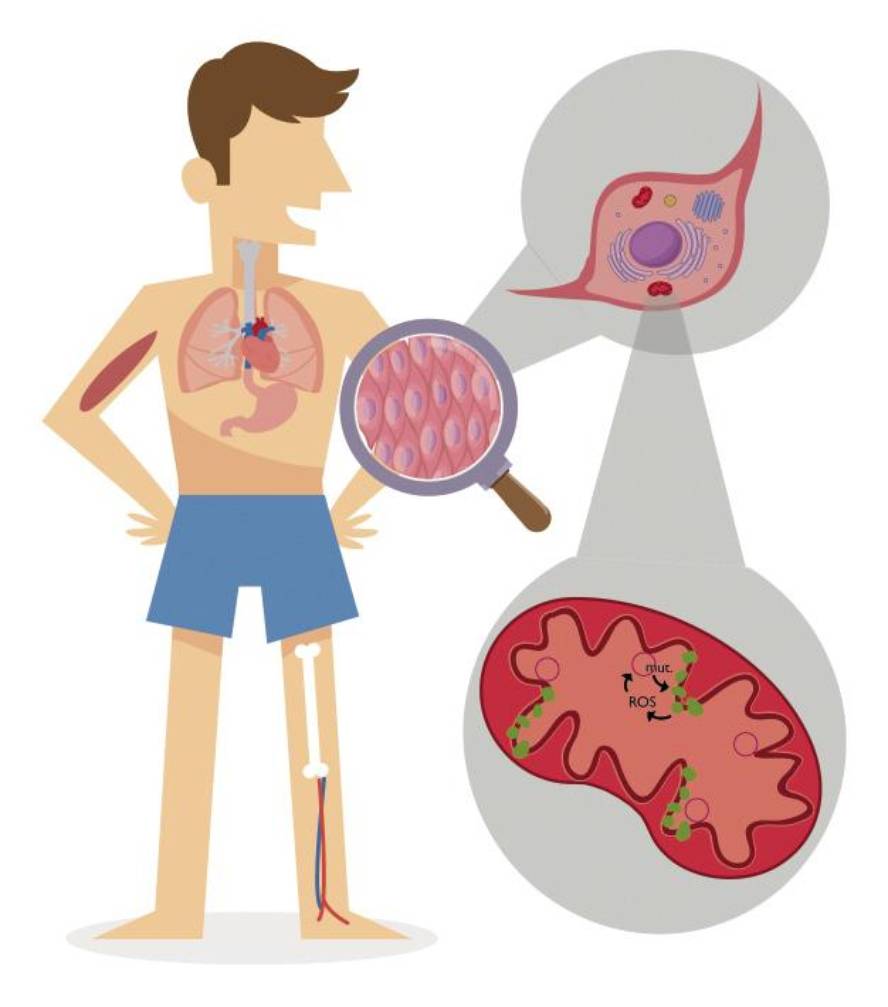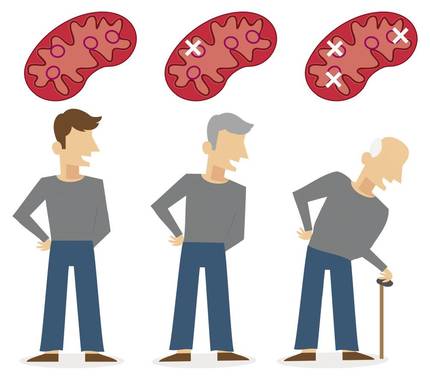Mitochondria and aging

Mitochondria are present in all human cells and it is often said that they are energy centers of cells. In fact, one of the main functions of mitochondria is the supply of energy to the cell, mainly using products from the digestion of food and oxygen we breathe. This process is known as cellular respiration.
A cell can contain a variable number of mitochondria depending on the functions of the cell, the need for energy and the cell phase; for this purpose, the mitochondria are able to fuse together to form a single one, or to fragment and create many small mitochondria. Not long, we will highlight two of the many characteristics of mitochondria. One, which are circular or oval structures surrounded by two membranes, and which have a capital importance, among other things because in the inner membrane occurs the synthesis of the above-mentioned energy. The other, which the mitochondria has its own genetic material, which encodes the structures necessary for its operation.
Aging process based on mitochondria
It can be said that aging is due to failures in the systems and apparatus of the body. In fact, although at different speeds, all body organs are aged. When we talk about cellular aging, there is a concept that must be clear: aging is a phenomenon that has occurred in exchange for cell differentiation. The original unicellular organisms were immortal. At one point in evolution, the multicellular life could be developed, since the cells began to divide into two and differentiate, and different types of cells appeared that could perform different functions. Thus, larger and more complex organisms (biological, morphological, functional, etc.) The division of labor allowed its appearance, but by achieving it they lost the ability to fragmentation and continuous regeneration of these cells, which was limited to sexual cells in multicellular organisms.
Why we get older, and how we can avoid this painful process, are two questions that are recently booming. Science has proposed numerous hypotheses to answer these questions, but most of these hypotheses have only identified the mechanisms and molecules that influence the aging process, still to be determined which are the real causes. At present, the most powerful hypothesis is that of the aging process based on mitochondria.
Reactive oxygen species (ROS, Reactive Oxygen Species) are certain chemical forms of oxygen that can be harmful to cells, as they can attack their multiple components, such as DNA, proteins, or lipid membranes. In addition, the main source of cell ross is mitochondria, respiratory chains of mitochondria. If there is mitochondrial DNA near these respiratory chains, the damage that these ROS can cause in DNA is much more violent than those that can cause in other biomolecules. And those damage to DNA are often mutations. Over the years, mutations in DNA accumulate; the more mutations there are, the more errors will occur in the mitochondria. In addition, mitochondrial DNA is more sensitive to any damage than that of the nucleus, since the mitochondrial is not wound in protective proteins, it has fewer mechanisms to repair the damage caused by ROS and the entire DNA sequence is encoding (the genes are one behind the other, it has no non-coding parts). Thus, due to the incorrect proteins generated by these mutations, the proportion of ROS that escape from the respiratory chains increases, which in turn carries more mutations. This cycle ends up causing the cell to lose control of its functions and processes, and when this occurs in many cells and tissues of the body, organs cannot function properly. That is the aging and the final situation of this process: death.
However, as usual in biology, this ROS function does not fully explain everything that happens in reality. The latest version of the aging process based on mitochondria slightly alters the role of ROS. According to this latest version, ROS would be a signal molecule that would communicate to the cell nucleus that mitochondria is damaged. This would put in place responses as alternative ways of obtaining energy (for example, fermentation), mechanisms to combat stress and synthesis of more mitochondria. It seems, therefore, that the process of aging based on mitochondria is not as catastrophic as we have exposed at first. On the contrary, it is important not to neutralize free oxygen radicals as they appear in the cell, since they are an indicator of the state of the mitochondria and a signal molecule, essential to generate effective responses for the cell.

And to fight aging, what?
Among the strategies being investigated to combat aging, the use of antioxidants is one of the most discussed. It seems that the body uses antioxidants to maintain at optimal levels the balance of oxidation and reduction (redox) reactions in cells. Therefore, the consumption of more antioxidants only allows cells to synthesize or process antioxidants during the time and energy needed, and to avoid excessive oxidation reactions more quickly. This is because ROS produce more oxidation reactions and antioxidants can help to recover optimal levels of redox reaction. But, like everything, it soon also has its back. It seems that cells are able to get enough antioxidants, control redox reactions, and those considered additives do not have at least a positive effect on aging. In addition, it has been commented that an additional consumption of antioxidants can contribute to avoiding excessive oxidation reactions more quickly, but this can be harmful to fight diseases like cancer. In fact, a natural strategy of the body is the oxidation of cells and, in this way, induce them to their death to avoid the uncontrolled growth of cancer cells, so if we consume antioxidants as additives, we exhaust these strategies. Finally, remember what has been said above: ROS are the signal molecule of the state of the mitochondria. Therefore, the results of the latest research indicate that we should not change the dynamics of reactive oxygen species, since the body has its mechanisms of regulation to let ourselves be carried on its own.
Our research line: Mitochondrial DNA and cholesterol
In our research group, Biodonostia, we are also investigating aging. Cognitive damage is a universal feature of aging and two factors that influence cognitive damage are the capacity for energy synthesis and cholesterol metabolism. Both components could be key in numerous neurological diseases, on the one hand, because the brain is the organ with the highest energy demand and, on the other, because it has been described how cholesterol participates in some neurological diseases such as parkinson or alzheimer's disease. In addition, we have recently shown that these two factors are not independent, but two closely related processes. Specifically, mitochondrial DNA, essential to produce energy, is physically associated with the inner membrane, among other things thanks to cholesterol. In adulthood numerous mitochondrial diseases appear, with mitochondrial DNA–cholesterol affected. However, our hypothesis is that this abnormal bond depends on age and, therefore, it also occurs in normal aging slowly and progressively.
Therefore, we are investigating how aging affects mitochondrial DNA and cholesterol, and whether the metabolism deficient of mitochondria and cholesterol coincides with cognitive damage. To do this, we are working in patients with neurological diseases, affected by errors in mitochondria and cholesterol, and the way in which the discoveries obtained from them affect the aging processes. The main objective is to design treatments that can slow or reduce cognitive damage and develop drugs to fight serious neurological diseases. In this sense, the drugs that interact with mitochondrial DNA and act on cholesterol have already been identified, so the next step will be to test them in neurological diseases and aging processes that open the door to a healthier and longer life.
In recent times, research that the rulers are subsidizing is more focused on improving the quality of aging than extending life expectancy. In fact, most advanced countries will have in the near future a model of society composed of old individuals. This is due to the low birth rates and to the deaths more and more late. However, it is good to improve the situation from a medical and biological point of view, but it will also have to improve the social sphere if you want to properly manage the problem of aging and ensure a decent quality of life. It will also be necessary to improve the pension plans, the resources offered to the dependent elderly and social assistance. But that does not depend on scientists.





